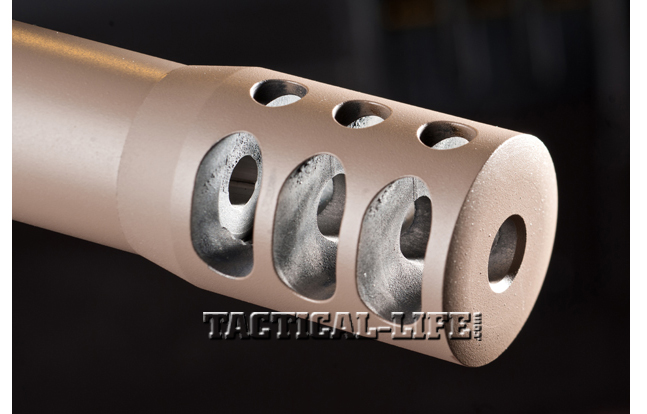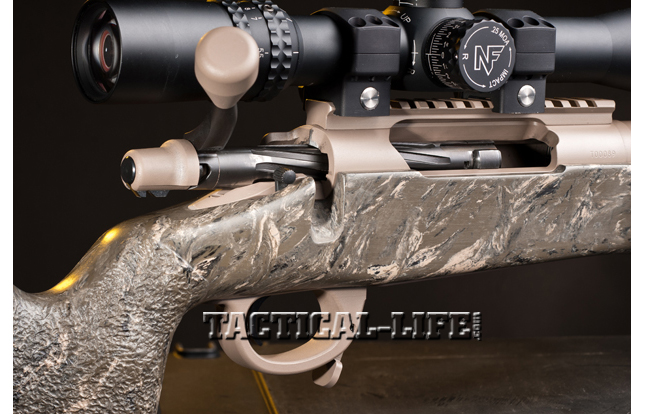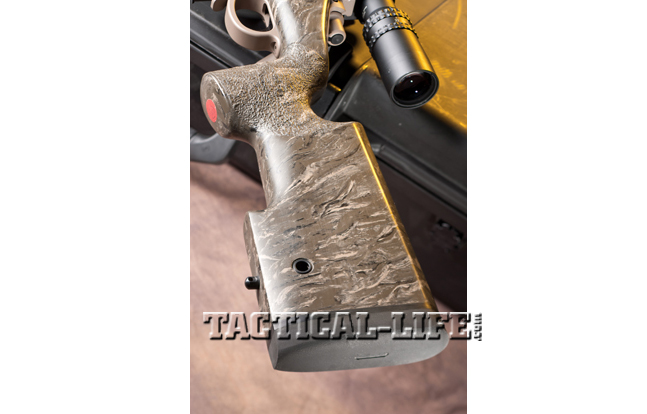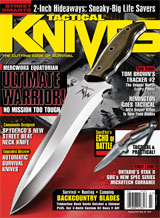After attending 22 SHOT (Shooting Hunting Outdoor Trade) Shows over the past 24 years, I no longer feel that “kid in a candy store” sensation that marked my first few visits. Nevertheless, it is always fun to see old friends and make new acquaintances. One of the most impressive people I met at the last SHOT Show was David Rooney, owner of Tactical Rifles. I had heard good reports about Tactical Rifles’ work from my friend, Staff Sgt. James Gilliland, and got a chance to shoot his Tactical Rifles-made .260 Remington M40 after a deer hunt last fall.
After a couple of days walking the aisles, I stopped by the Tactical Rifles booth to meet Rooney and talk rifles. We found that we share a common affinity for .264 bullets for long-range work. Rooney was excited about a new 6.5mm-06 that he had built. Now, I’m a big fan of the .260 Remington with high ballistic-coefficient bullets, but he assured me that the extra velocity of the same projectiles fired from a longer 30-06 case would increase the reliable range beyond 1,000 yards.
“Many people talk about the 6.5 diameters, as they have realized it is just a great wind-bucking B.C. that allows you to hit little targets way out yonder,” Rooney said. “The 2,600 to 2,700 fps range is great, but for 1,000 yards and beyond, the extra 200 fps is what’s needed if you want not just to compete, but to win. Speeding up the round and increasing the B.C. of the bullet reduces wind drift and makes long range precision more achievable.
Advertisement — Continue Reading Below
“Five inches less wind drift at 1,000 yards may not seem like much, but that’s what separates the winners from the losers in competition,” Rooney continued. “That’s why the 6.5-284 wins so many benchrest competitions; but it doesn’t like magazines, so it is almost always used for single shot rifles. It gives comparable ballistics, and maybe even better at max loads, but with the ability to feed in a standard long-action magazine, and enter the 6.5-06. The .30-06 has worked great for decades, but doesn’t offer significant advantage in ballistic coefficient. The 6.5-06 offers huge advantages at long range without being a magnum, throat-burning, hard-kicking beast! In fact, with a brake installed, the 6.5-06 barely moves when fired.” One thing led to another, and I’d arranged to borrow Rooney’s 6.5-06 for a bit of shooting.
First Impressions
When I received the rifle, it was easy to see that the action has the same footprint as a Remington 700, but in stainless steel and made to benchrest tolerances. When I pulled the bolt from the case, it was also obvious that it has a very reliable M16-style extractor.
Advertisement — Continue Reading Below
After putting some rounds downrange, I got in touch with Rooney and was treated to more of his ideas on building custom precision rifles.
“Relying on the underside of a receiver to hold staggered rounds has never been the most reliable means of feeding,” Rooney said. “As the bolt is a circular piece of steel, the sides of the radius will always have the least amount of contact with the head of the round in the staged magazine well. The lowest point of the radius of the bolt face is the center. It is, therefore, correct to conclude that for optimal feeding reliability, a bolt rifle should have center feeding. This ensures maximum contact with the head of the cartridge. The mil-spec, double-stack, center-feed magazine that we utilize not only achieves this aim, but also controls feeding for the round’s first inch of travel, ensuring correct presentation into the chamber,” Rooney stated.
Mounting
Long-range Optics
Advertisement — Continue Reading Below
Early on, while discussing the project with Rooney, I decided that a Nightforce NXS scope would be a perfect fit to get the most from the 6.5-06. I chose a variable 5.5-22X with a 56mm objective. As you might expect, this optic has a 30mm tube. The adjustment range for this scope is commendable, with 100 MOA in elevation available, and 60 MOA of windage. Both adjustments are made in .25-minute clicks. I selected Nightforce’s mil-dot reticle. This is a second focal plane optic, which means that the scope must be set at 11X to align the mil-dots for Mil ranging. The dots themselves are a circle the size of a normal mil-dot, with a very fine dot centered within.
To firmly affix the Nightforce optic to the rifle, I used Tactical Rifle’s Chimera Tactical 30mm Rings. These rings are constructed from an advanced titanium alloy, reducing overall weight, while providing plenty of recoil resistance and strength. To give you an idea of how strong: The rings’ body has 83,000 pounds-per-inch tensile strength, and the cross bolt has 120,000 pounds-per-inch tensile strength. The cap screws on these rings are beefy. Rather than industry standard 8-40s, they’re 8-32s, which give 45 percent more clamping area under each screw head. If that wasn’t enough, there are six, not four, screws on each ring. You get perfect reticle alignment through precision boring that keeps alignment to plus/minus 0.002 inch. Each set is sold as a serial-numbered matched set for Mil-Std-1913 rails only.
Class Action
In contrast to factory rifle manufacturers, custom rifle makers will commonly “true” an action to lay the groundwork for building a custom gun. “All factory rifles have the same common problem,” Rooney said, “they have horrible alignment. Predominately the mating between the receiver, recoil lug and barrel is poor. In layman’s terms, the barrel is screwed on crookedly! Combine this with a sloppy factory “machine-gun” chamber, and you have mediocre performance at best. True, you can get a Monday-morning factory rifle that shoots like a dream, but they are few and far between, and normally only perform well with tailored handloads.
Advertisement — Continue Reading Below
“Handloads are traditionally thought of as being more accurate when neck-sized only,” Rooney said “Let’s think about this for a second. We absolutely put the cart before the horse, as use of neck sizing for enhanced performance does not change the accuracy potential of the ammunition, only the chamber for which it is fitted! In other words, we are compensating for poor alignment and chambering in the rifle and believing that the ammo is more accurate. We stick a Band-Aid on the problem. What we do is address the accuracy issue at the source by identifying that there are just two main areas for precision; alignment and harmonics. Fix them both, and you can shoot .25-MOA potential with factory match ammo. That is part of the picture that ‘truing’ addresses; re-machining an action so that it’s no longer crooked.”
Barreling Through
When I asked the veteran gunsmith about barrels, his insights were enlightening. “Barrel manufacturers—well here’s a subject full of mystery, sorcery and incantations. Or, rather it’s not,” Rooney said. “The barrel blank manufacturer has little to do with the precision of the rifle. Think about it, a bad crown or chamber yields horrible accuracy, irrespective how lovely the blank was before a retarded monkey cut a nasty chamber. Accuracy is created by the beginning and the end of the barrel, not the few inches between. Now don’t get me wrong, a $40 factory blank doesn’t compare with a $300 benchrest blank, but other than the quality of the hand lapping, all the top quality barrel blanks offer the same accuracy potential.”
Advertisement — Continue Reading Below
If a blank canvas is an artist’s potential for a great work of art, a rifled barrel blank serves as the genesis for a rifle-building artisan. It is as if the rifle comes to life when its chamber is cut. “Chambers are the heart of the rifle,” Rooney said. “No matter what you do, if your chamber is bad, then your accuracy will be poor. Think of it simply, if the case is not held snugly in the same place every time around is loaded, how can accuracy be good?
“Sloppy factory chambers are designed to compensate for a myriad of indiscretions,” Rooney said. “Any old, nasty, foreign, delinked ball ammo will go bang and head in approximately the same direction, but a precision rifle is to be fed quality ammo. You wouldn’t buy a Lamborghini and fill it with 87 octane, then have a surprised look on your face when things didn’t progress too well—and it’s just the same with quality rifles. Quality rifle plus quality ammo equals excellent results. All our chambers are zero-headspace-minimum SAAMI spec, so the case is supported consistently, and thus bullet-to-rifling engagement is consistent. On a factory rifle, the bullet may enter the barrel crooked, and thus wobble is introduced into the flight of the bullet before it’s one inch down the barrel.”
Once the action and barrel are in perfect alignment, a second critical aspect comes into play. “Remember what we said about alignment,” Rooney asked. “It just reared its ugly head again. Mate the shoulder of the barrel with the face of the receiver with a poorly machined recoil lug and you have a rifle that will shoot around corners, not into the same hole. This area is pathetically inexpensive to resolve with a precision-ground recoil lug, but you know when a board meeting or dividends are involved, saving $30 is a big deal across thousands of units monthly. With us, we don’t cut corners—ever, on anything.”
Advertisement — Continue Reading Below
Continuing his accuracy primer, Rooney shared some of his thoughts on triggers. “Lots of people bark up the wrong tree with triggers,” he said. “They ask for 1-pound pulls when all that a super-light pull achieves is potentially dangerous sear engagement. The question should be about creep and over travel. Remove both and, with a decent pull weight set at 2.5 pounds, you can shoot groups into a single hole, if you’ve got a decent shooter, decent ammo, and Mother Nature’s cooperation.”
Gun Details
Rooney’s .65-06 rifle wears a Tactical fiberglass stock very similar to McMillan’s M40 tactical stock. The stock offers two forward sling-swivel studs to which one can attach a bipod and sling. The stock also features flush-cup swivel attachment points fore and aft on the left side. The rifle comes with single-stack Accurate-Mag box magazine. The 700-style action is Tactical Rifle’s own Chimera action. The bottom metal on the rifle is outstanding. The triggerguard is extra beefy to withstand unusual abuse. Mounted in the front of the triggerguard is a paddle-type magazine release lever to allow the shooter to drop a magazine without having to remove his trigger hand from the grip. The trigger is exceptional, too, breaking the sear at approximately 3.5 pounds with no creep or overtravel. The barrel is hand-lapped stainless steel, match grade and features a match-grade chamber and a muzzle diameter of approximately .850-inch at 26 inches. Tactical Rifles’ own muzzle brake makes this rifle during shooting feel like a rimfire.
Advertisement — Continue Reading Below
Range Work
Shooting was conducted on multiple days under varying temperature and wind conditions. Temperatures ranged from 73 degrees to 98 degrees, and wind conditions were all over the map. All the shooting was from a rock-solid bench. Velocity data was recorded with two chronographs placed 15 feet from the muzzle: an Oehler 35P and a Shooting Chrony Gamma Master.
I was rather limited in my choice of 6.5-06 loads. The two rounds I used in testing were Rooney’s experimental handloads. The first load contained 53.5 grains of IMR 4831SC driving a 140-grain Berger VLD bullet. Ten shots across the Shooting Chrony averaged a muzzle velocity of 2,793 fps. The extreme spread was 112 fps, and the standard deviation was 29.71 fps. To double-check the velocity data, I set up my Oehler 35P on a day when the temperature was 98 degrees. I fired five shots and found that average was 2,795 fps. The extreme spread recorded was 50 fps, and the standard deviation was 21 fps. The smallest 100-yard group I fired with this load measured .64-inch. At 500 yards, this load’s smallest five-shot group spanned 2.86 inches center-to-center. The vertical measurement was 1.43 inches, which is significant owing to winds varying between 6 and 12 mph. At 700 yards, the sole group I fired with the four remaining rounds opened up appreciably to 8.38 inches center-to-center. Varying crosswinds on the range significantly influenced the group, which presented a vertical dispersion of 4.56 inches.
Advertisement — Continue Reading Below
With the 130-grain load, the Shooting Chrony recorded a 2,827 fps average for a five-shot string. I had actually fired 10 shots, but the variability of the first five shots seemed too broad to serves as a basis for an accurately analyzing the load’s velocity. The extreme spread of the last five shots was 71 fps. Double-checking the velocity data, I again, on the same day, used the Oehler 35P when the temperature was 98 degrees. The average velocity was 2,836 fps. The extreme spread for five shots was 64 fps, with a standard deviation of 24 fps. The smallest 100-yard, five-shot group measured 0.32 inch, with multiple groups beating the gun’s 0.5-inch guarantee. Stretching the distance to 500 yards, the 130-grain load produced a 4.7-inch group center-to-center. The vertical dispersion measured 2.65 inches. Moving to 700 yards, I fired two groups. One group measured 8.26 inches, with a vertical measurement of 5.1 inches. The other group measured 6.05 inches center-to-center, while spanning 3.65 inches vertically. Again, cross winds, blowing right to left and left to right downrange, played havoc with each bullet’s horizontal dispersion on target.
Double-checking the two chronographs against each other verified that each was providing reasonably accurate data. These two loads provide good accuracy, but the rifle is capable of achieving better with further load development. Given the rifle’s .33-MOA capabilities at 100 yards, with a few fine-tuned loads, 3-inch groups at 700 yards seems perfectly obtainable.
For more information, visit tactical rifles.net or call 877-811-4867.





































